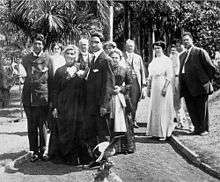Joseph Kaiponohea ʻAeʻa
Joseph Kaiponohea ʻAeʻa (June, 1882 – November 14, 1914) was the adoptive son of Queen Liliʻuokalani under the Hawaiian tradition of hānai. He was considered her favorite hānai son.[1]


Biography
He was born in June 1882 to Joseph Kapaeau ʻAeʻa and his wife Kaheo ʻAeʻa. Both his parents were pure Native Hawaiians and retainers of the future Queen Liliʻuokalani, who was heir-presumptive to the Hawaiian throne at the time.[2] Not having any children of her own, Liliʻuokalani adopted the infant boy under the Hawaiian tradition of hānai. She named him Joseph Kaiponohea ʻAeʻa and referred to him as Kaipo throughout his life. Besides Kaipo, she also adopted Lydia Kaʻonohiponiponiokalani Aholo and John ʻAimoku Dominis.[3]
Historian Helena Allen described how the Queen "adored him — a curly haired, bright-eyed toddler — her heart contracted every time she saw him".[4] Both biological parents took advantage of Liliʻuokalani's love for Kaipo to extort favors and debt forgiveness from her, blackmailing her by threatening to take their son away if she refused.[5]
He was educated at Fort Street School and ʻIolani College and graduated in 1900 from the Kamehameha School for Boys. In 1901, he was recommended as a candidate for the United States Military Academy at West Point by Delegate Robert William Wilcox, but he failed to pass the English section of entrance examination.[6][7] After his failure, Wilcox chose part Native Hawaiians: E. Vivian Richardson, who declined the nomination, and later Clarence Kumukoa Lyman, who became the first Native Hawaiian to attend West Point.[8]
ʻAeʻa worked as a stenographer and clerk in the Honolulu clerk's office.[9] In 1909, he was named in the queen's deed trust as a beneficiary in which she willed him Kealohilani, her Waikiki residence, and the fishery grounds of Hamohamo.[10] He never married or had children. While at the Waikiki home of Kealohilani, Kaipo died on November 14, 1914, at the age of thirty-two. The cause of death was Bright's disease. Following a funeral service at St. Andrews Cathedral, he was buried the following day at the upper Manoa cemetery. Too ill to attend the funeral, Liliʻuokalani remained in at Washington Place in mourning for her hānai son.[9][11]
References
- Allen 1982, p. 360.
- Allen 1982, pp. 160–162.
- Bonura & Witmer 2013, pp. 109–115.
- Allen 1982, pp. 177–178.
- Allen 1982, pp. 207–208.
- "Cadet to West Point". The Hawaiian Star. VII (2780). Honolulu. February 11, 1901. p. 1. Retrieved July 3, 2016.
- Smith, Walter G., ed. (April 25, 1901). "Untitled". The Pacific Commercial Advertiser. XXXIII (5840). Honolulu. p. 4. Retrieved July 3, 2016.
- "West Point Cadetship". The Hawaiian Gazette. XXXVI (34). Honolulu. April 26, 1901. p. 4. Retrieved July 3, 2016.; "They Want To Carry Swords". The Pacific Commercial Advertiser. XXXIII (5852). Honolulu. May 9, 1901. p. 3. Retrieved July 3, 2016.; "For West Point". The Independent. XII (1898). Honolulu. May 9, 1901. p. 3. Retrieved July 3, 2016.
- "Prominent Hawaii Is Laid To Rest". Honolulu Star-Bulletin. XXII (7052). Honolulu: Oahu Publications, Inc. November 16, 1914. p. 2. Retrieved July 3, 2016.
- Iaukea 2011, p. 75.
- Allen 1982, pp. 384–385.
Bibliography
| Wikimedia Commons has media related to Joseph Kaiponohea ʻAeʻa. |
- Allen, Helena G. (1982). The Betrayal of Liliuokalani: Last Queen of Hawaii, 1838–1917. Glendale, CA: A. H. Clark Company. ISBN 978-0-87062-144-4. OCLC 9576325.CS1 maint: ref=harv (link)
- Bonura, Sandra; Witmer, Sally (2013). "Lydia K. Aholo — Her Story Recovering the Lost Voice". The Hawaiian Journal of History. Honolulu: Hawaiian Historical Society. 47: 103–145. hdl:10524/36266. OCLC 60626541.CS1 maint: ref=harv (link)
- Iaukea, Sydney L. (2011). The Queen and I: A Story of Dispossessions and Reconnections in Hawaiʻi. Berkeley: University of California Press. ISBN 978-0-520-95030-6. OCLC 763161035.CS1 maint: ref=harv (link)